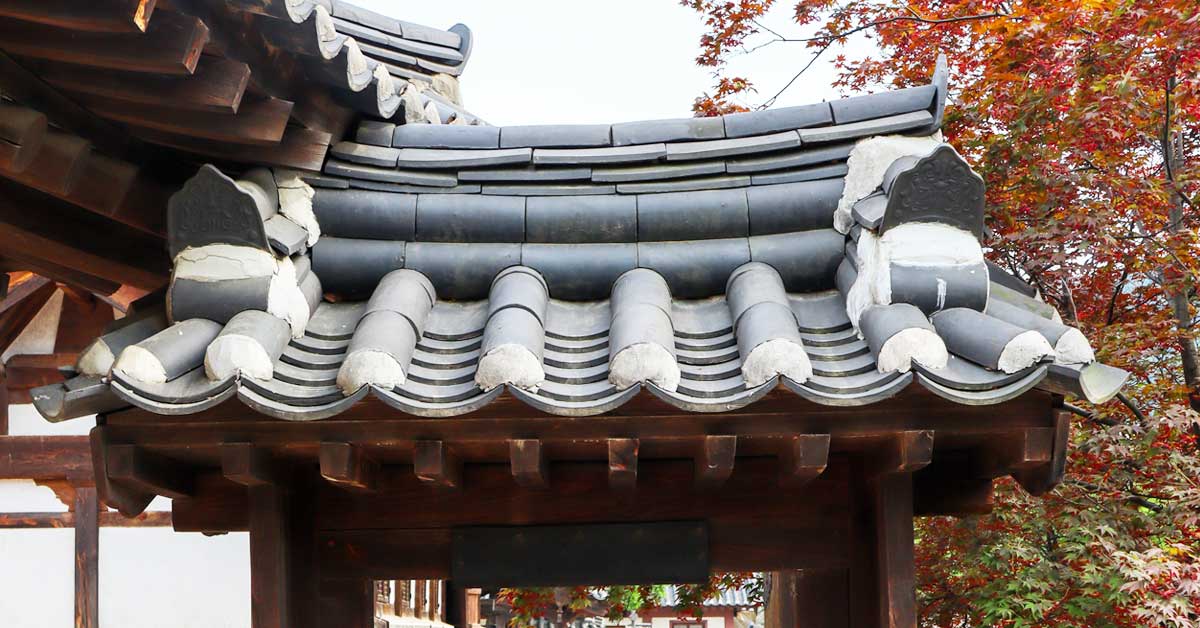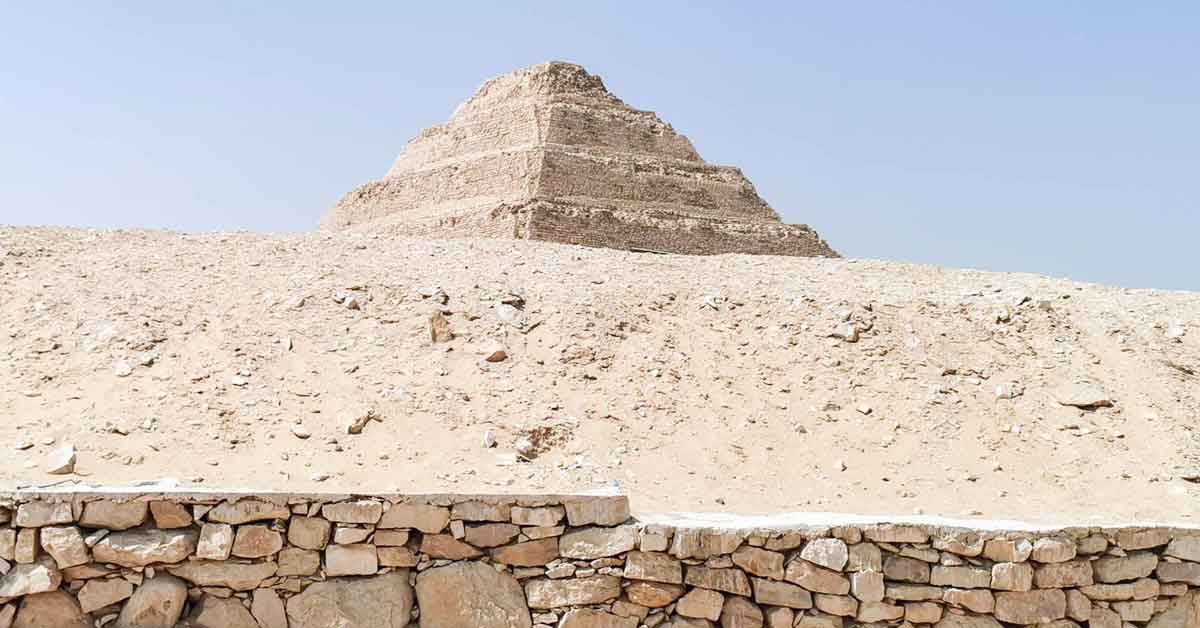Bukchon Hanok Village Guide & Map: A Living Story of the Joseon Dynasty (Updated 2025)
A long list of out-of-this-world things to do in Bukchon Hanok Village, Seoul, South Korea. Ready?
The ancient South Korean Bukchon Hanok Village is a rare time-machine neighbourhood. An attraction worth of topping any list of places to visit in Seoul. The village takes you back more than 600 years ago, to the ancient Joseon Dynasty era, while confining pieces of what used to be the lifestyle of the upper class of those times.
In all my travels, I have hardly ever seen such a surprising urban artefact.
Bukchon means Northern Village and it was called so due to its strategic position on the Joseon Map, north of Cheonggyecheong Stream and Jongno.
Traditionally, this was the residential quarter of high-ranking government officials and nobility. Even though some of the old hanoks have been modernized being transformed into the so called fusion hanoks, there are still plenty of well-conserved examples of art and architecture reminding of the ways old Koreans used to live.
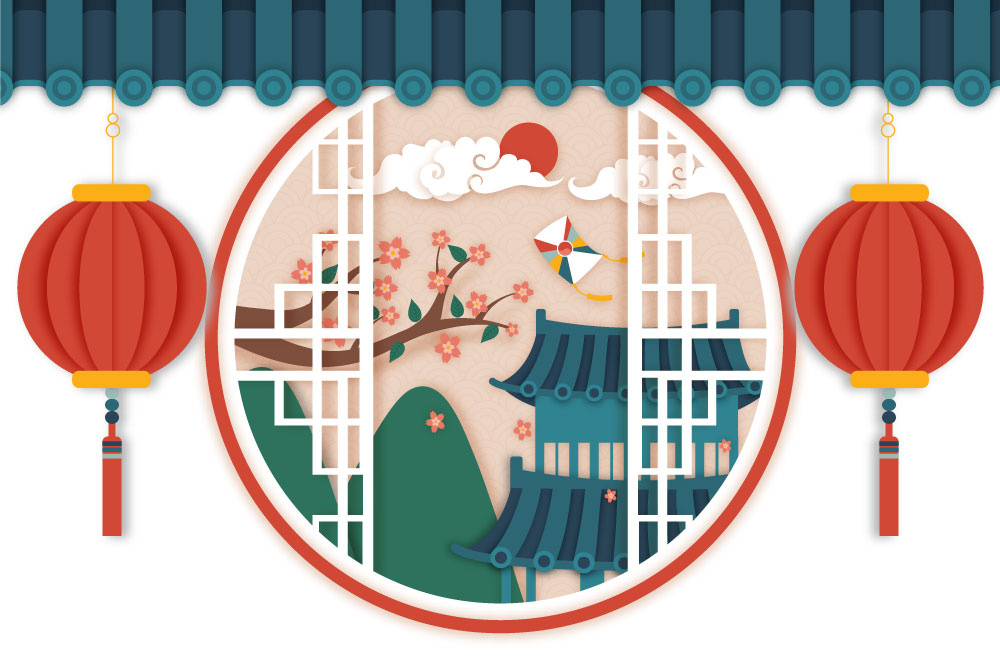
Bukchon Village is nowadays a home to over 900 traditional Korean houses (hanoks) dating from the times of the Joseon emperors. And one of the most beautiful Hanok villages in South Korea. However, the fascinating thing about this place is that people continue to live there, as in any other normal neighbourhood. Right behind those beautifully crafted massive wooden gates and tall brick walls.
Disclosure: This article might contain affiliate links. If you make a purchase after clicking one of these links, I earn a small commission from that website at no extra cost to you. Learn more: Disclosure policy.
The lovely Seoul neighbourhood bursts during the day with lots of small craft stores, restaurants and cafes and traditional workshops. I spent there 3 full days. And, because not all of these places open at the same time, in each of the 3 days, the village seemed to have a brand new face.
Each time, a newly opened door was changing the urban setting and the atmosphere. Hard not to become more and more addicted to discovering each hidden corner.
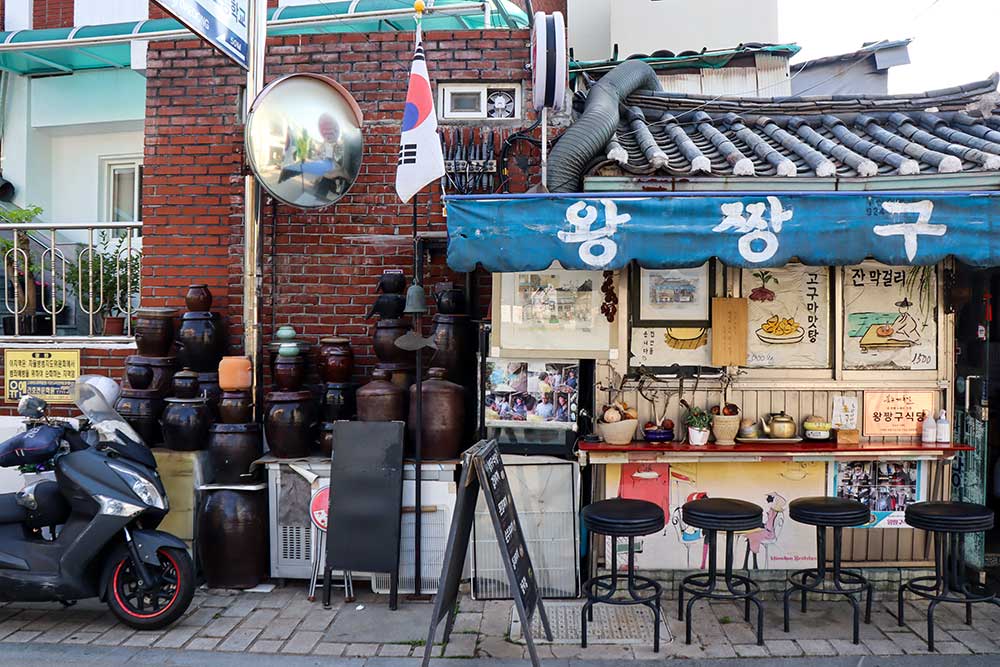
Old Hanok Fast-Food Restaurant in Bukchon, Copyright © Cooltourismical.com
Getting into the neighbourhood, you give you the opportunity to see tiny interiors and beautiful gardens hidden by meticulously designed, wooden gates, taste some traditional Korean food or wear a Hanbok. Or even sleep inside the most prominent example of ancient architecture: the Hanok, the traditional Korean house.
The Korean Hanok Village sits over a hilly area. Therefore, many of the streets are sloping roads or tiny alley going up and down along white brick walls. Seen from the highest points on the hill, Bukchon reveals itself as a cluster of tiled, curved roofs, broken by small patios.
The whole place is surrounded from almost all sides by ancient royal settlements: Gyeongbok Palace, Changdeok Palace and Jongmyo Royal Shrine.
 How to get to Bukchon Hanok Village
How to get to Bukchon Hanok Village
Public transportation is very well connected in Seoul and most cost efficient. And taxis, as well as Grab, are extremely affordable. Any time difference between small car and public transportation would be hard to notice.
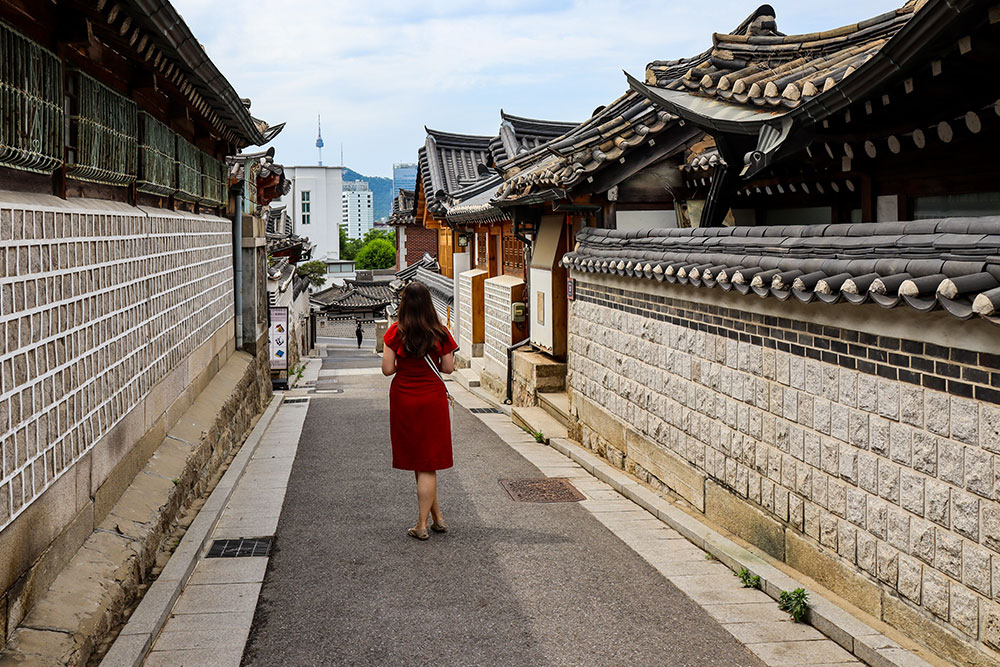
Random street with traditional hanok architecture in Bukchon, Copyright © Cooltourismical.com
If you plan to take the subway, the closest subway station is Anguk Station [안국역]. You can get there by Seoul Subway Line 3. And to make it easier go out on exit 3 and head left on Gyedon-gil for about 200 m.. This road will bring you to Bukchon Traditional Culture Center, best place to start your journey.
In case it happens to leave the station at exit 2, then head straight on Bukchon-ro for about 200m and take right on the first big street Bukchon-ro 4-gil for another 150m. And you will find yourself in the same spot as above.
Also, the two buses Jongno 01 and Jongno 02 have multiple stations right inside the village. You can get around using them.
 Things to do in Bukchon Hanok Village
Things to do in Bukchon Hanok Village
Bukchon Village offers to its visitors a bit of everything. And at the same time, some of the most interesting things to do in Seoul. Not only that it is surrounded by vast, old palaces that can be visited for a modest fee, but the neighbourhood on its own is filled with artisan workshops, cultural centres and modern art museums ready to be explored.
Besides that, having a tea, eating a traditional meal or spending the night in an old Hanok can also be part of the experience.
Even so, it all starts with a long walk among 600 years old historical buildings that seem to not have aged even a bit. At least for me, this was the most charming part. Discovering cute, little spots hiding art of all sorts.
💭 Learn about Bukchon’s history & culture
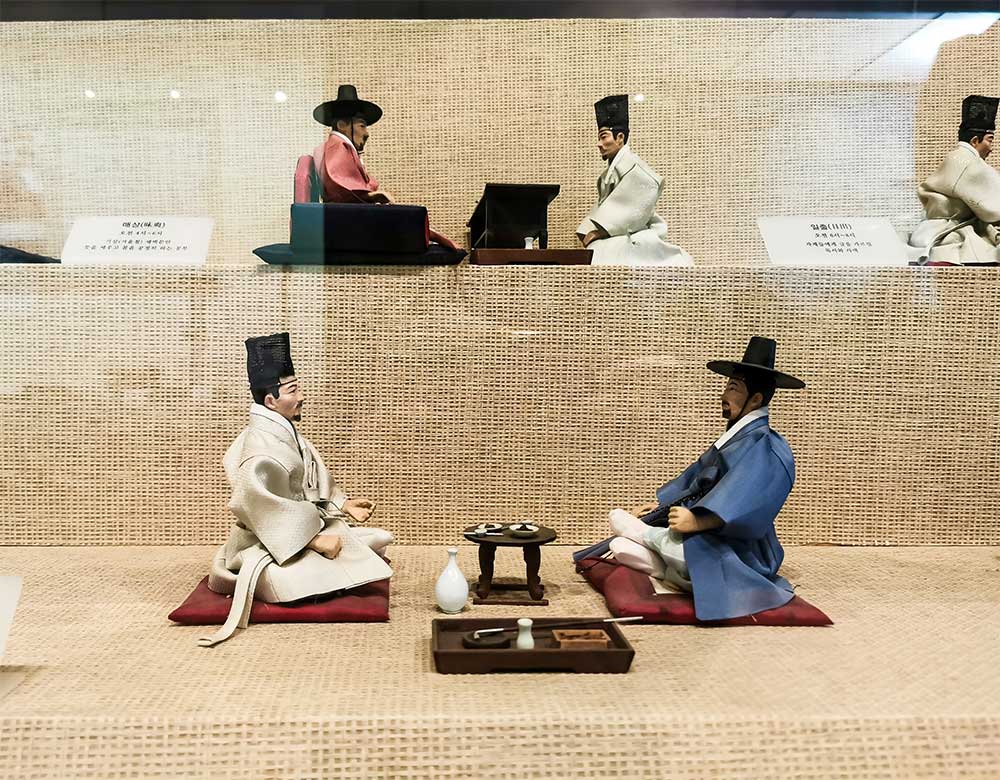
Teachers of the Joseon Dynasty, Model inside the Seoul Education Museum, Copyright © Cooltourismical.com
In the midst of a cultural and social outburst of such a place like this pretty neighbourhood in the heart of Seoul, the easiest thing to do is letting yourself bewitched.
Wherever I looked around me, in every standing thing, in every written word, culture seemed strongly interconnected to design. From well-preserved housing and an ancient grid that the little alleys still follow to the smallest details of clothing, food, arts and crafts.
One thing that’s for sure is that Bukchon gets all its particularly mystical energy from design. From the values, norms and history of design. The atmosphere inside the Korean village actively integrates you, it surrounds you with knowledge, sweetness, calm and a gentle noblesse.
That comes from design being integrated in all aspects of life, tangible and intangible heritage.
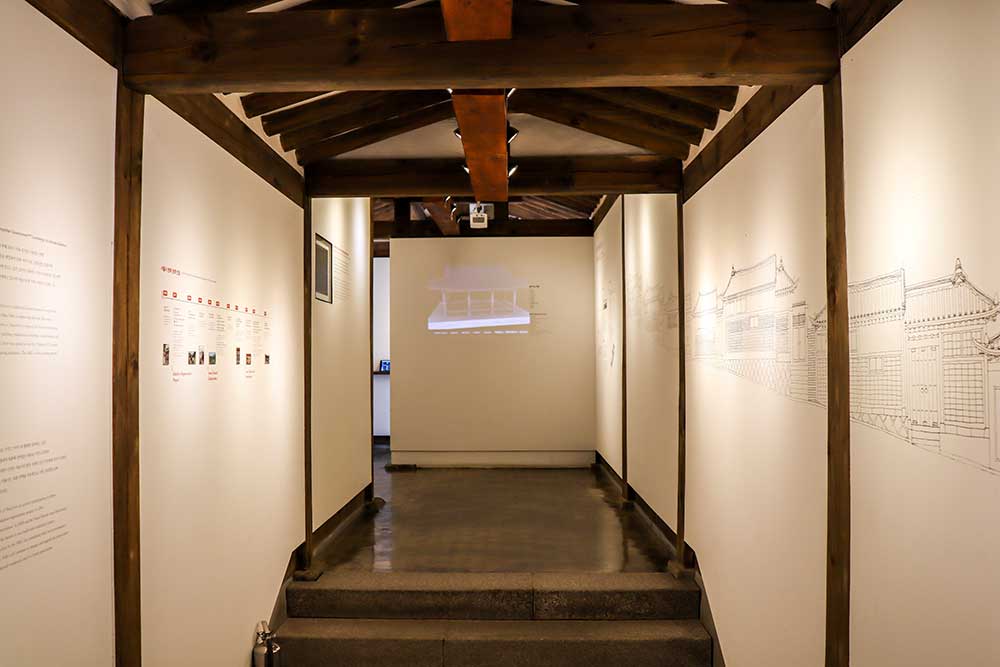
Best place to start is Bukchon Traditional Culture Center, former home of a finance minister during the Joseon period. Nowadays, it promotes history and traditions of the Hanok through lectures and movie screenings, a small informative museum, cultural programs connected to calligraphy, tea ceremony, musical storytelling or craft classes involving natural dyeing, black bamboo, jogakbo (patchwork).
For a more thorough understanding of the Korean home, there is also Hanok Support Center. Besides that, Bukchon Museum exhibits various artefacts gathered from around the village, while elaborate models of traditional buildings and construction tools can be found at Seongjae Traditional Architecture Museum.
Last, but not least, the Seoul Education Museum tracks back tracking back the development of the city’s educational process by hosting some fascinating 3D models of the learning environment across the ages, dressing of old scholars, ancient books, and more.
Cultural places to learn about Bukchon’s past:
- 📌 Bukchon Traditional Culture Center: South Korea, Seoul, Jongno-gu, 계동길 37(Google)
- 📌 Hanok Support Center: 11-7, Gyedong 2-gil, (Google)
- 📌 Seoul Education Museum: 48 Bukchon-ro 5-gil, Jongno-gu, Seoul (Google / Kakao)
- 📌 Seongjae Traditional Architecture Museum: 19 Changdeokgung 1ga-gil (Google / Kakao)
- 📌 Bukchon Living History Museum: 21 Samcheong-ro 4-gil, Jongno-gu, Seoul (Google / Kakao)
👣 Hanok Village Walking Tours
The best way to get acquainted with the ancient charm of a place like Bukchon Hanok Village is definitely on foot. While being there it never crossed my mind I could choose anything else. Just because there is something to see and do at every step.
Plus, not only as a crowded cultural and artistic cluster, but also due to its narrow, maze-like alleys, this lovely Seoul neighbourhood would be difficult to explore any other way.
If you’re new to the place, the hassle-free choice is to pick a guided walking tour. That would help you getting used to the place faster, finding out some insider tips, learn about the community and Korean heritage.
In this sense, you can choose a free tour, similar to a history class, offered by the City of Seoul administration. The tour takes about 2-3 hours and it benefits of expert multilingual guides.
- 🛑 Reservations must be made online, at least three days in advance, here.
There are also some paid Bukchon walking tours available, with locals or tourism agencies. These are more personalized and offer a more modern, social-kind perspective than a historical one, including insights and tips about restaurants, bars, today’s cultural life and events.
- 🤫 This ancient Korean village is an actual residential area! Therefore, some extra-care is needed in what concerns noise or photos.
🏠 Visit an Open House
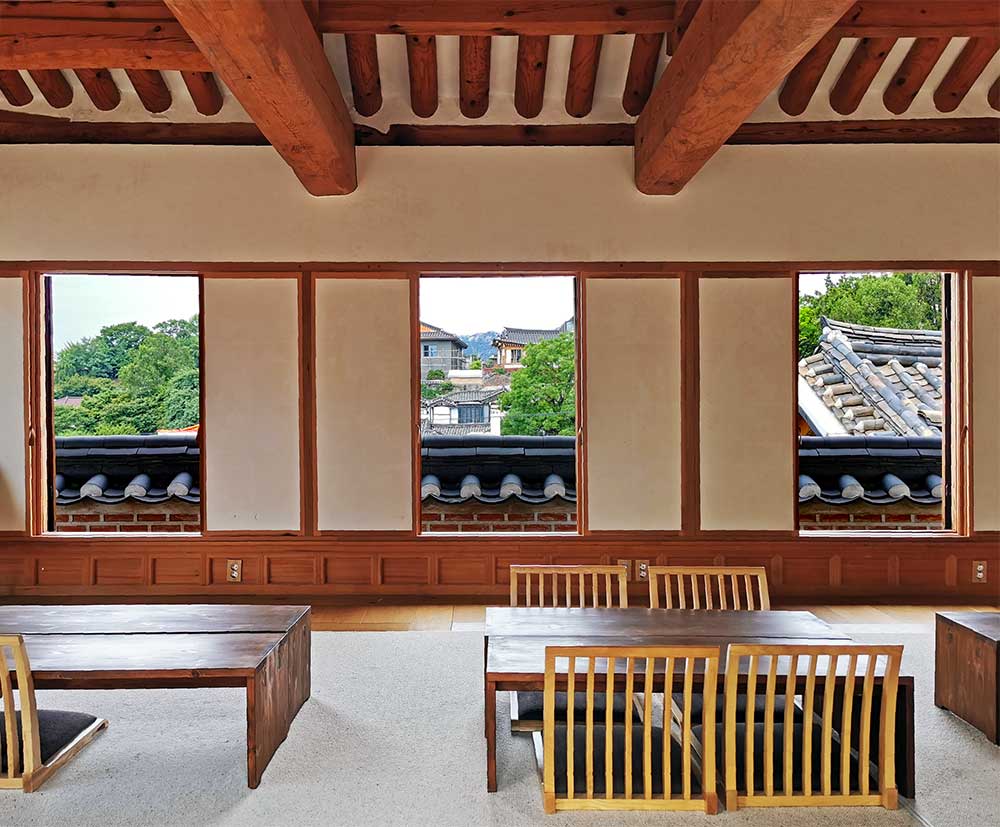
Hanok Hall Interior, Copyright © Cooltourismical.com
The most special thing about Bukchon Hanok Village in Seoul is its architecture. Traditional Korean houses, once homes to most influential people of the Joseon era, are nowadays well-preserved examples of old construction and design techniques.
Most of them are still inhabited, some have been transformed into businesses where people can meet, eat and shop, while others are just open to the public, for visiting, free of charge.
These latter ones are often not crowded, because they seem not to offer anything special. But they do offer. Hanoks can shed light on intricate structural wood joinery and delicate decorative crafting. They can silently whisper about spatial configuration and building materials, strongly connected to the nature and its changing seasons.
Korean housing can prove magic is possible. Through the ondol, the heated flooring, fire and wood coexist at the very heart of a hanok, even when not likely to be compatible.
On top of that, each largely-opened window reveals a unique landscape of the surroundings. A real painting filled with sun light, framed by wood and shadowing hanji walls. Hanok’s interior becomes a background for nature. And not the other way around. Like the little universe of a vintage projector slide, lit from behind.
Above all, the silent beauty of the hanoks stays in their miraculous simplicity and spirit of nature.
Open hanoks in Bukchon neighbourhood:
- 📌 Bukchon Hanok Hall: 29-1 Bukchon-ro 12-gil, Jongno-gu, Seoul (Google / Kakao)
- 📌 Baek Inje’s House, unique black pine mansion: 16 Bukchon-ro 7-gil, Jongno-gu (Google / Kakao)
- 📌 House of Go Hui-Dong, Korean painter: 16 Wonseo-dong, Jongno-gu, Seoul (Google / Kakao)
- 📌 Bae Ryeom’s House Museum, Korean painter: Seoul, Jongno-gu, Gye-dong, 72 (Google / Kakao)
- 📌 Yun Po-sun’s House, Former Korean President: 62 Yunposun-gil, Jongno-gu, Seoul (Google / Kakao)
🖌️ Master an ancient Korean skill
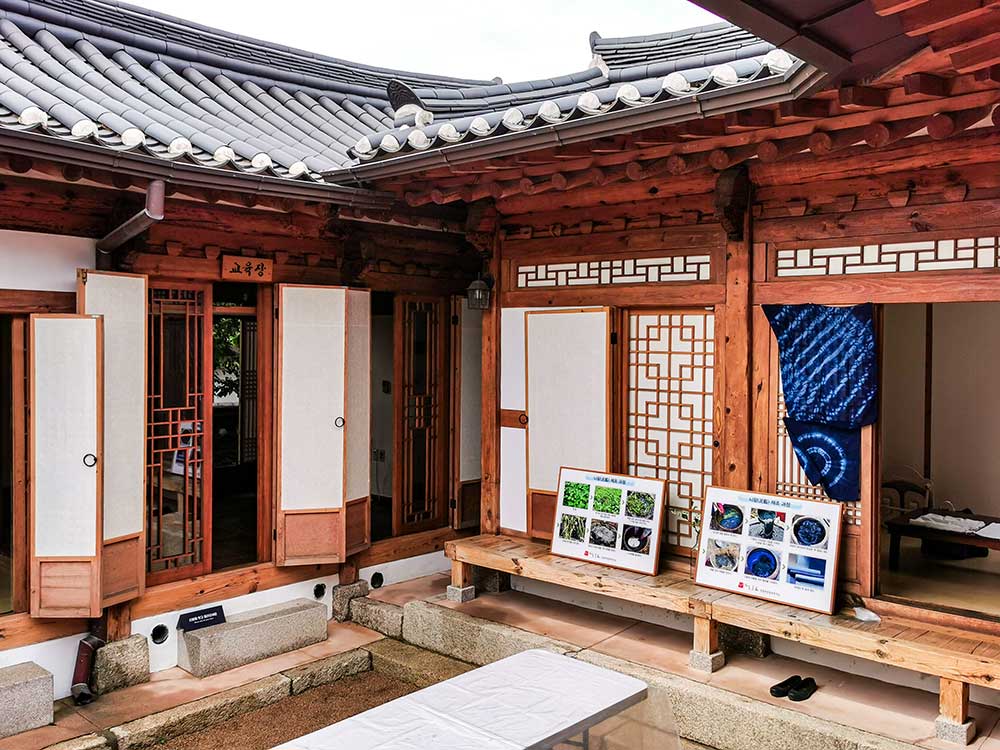
Bukchon Traditional Crafts Center, Copyright © Cooltourismical.com
Inside Bukchon Hanok Village, residents have been trying to preserve not only the unique architecture of the Joseon era, but also particular Korean arts and crafts.
For hands-on cultural experiences, you can always go to Bukchonn Traditional Crafts Center. There, depending on the day of the week and hour, you can choose one of the programs available: tea ceremonies, calligraphy, embroidery, hanji crafting, textiles painting. The accept walk-ins and prices are around 10 000 to 15000 won.
Otherwise, for more in-depth Korean craft classes, you can make a booking for an individual workshop held by local artists and designers in their own studios.
Workshops & Craft Masters in Bukchon Hanok Village:
- 📌 Bukchon Traditional Crafts Center: 24-5 Bukchon-ro 12-gil, Jongno-gu, Seoul (Google / Kakao)
- 🪢 Donglim Knot Workshop, by Shim Young-Mi; Add.: 11-7 Gahoe-dong, Jongno-gu; Tel: 0236732778;
- 🪁 Joseon Folk Kite Making, by Rhee Kitai; Add.: 4, Changdeokgung 5-gil, Jongno-gu; Tel: 02-720-4114
- 🎎 Hanji Doll Workshop, by Hong Byeokheon; Tel: +82-10-5274-6404; Add.: Google
- 🪡 Embroidery & Patchworking, Han Sang Soo Museum; Add.: 29-1 Bukchon-ro 12-gil, Tel: 02-744-1545;
- 🪵 Korean Window Woodcraft, by Sim Yong-sik; Add.: 27, Bukchon-ro 6-gil, Jongno-gu; Tel: 02-715-3342.
🎎 Rent a Hanbok
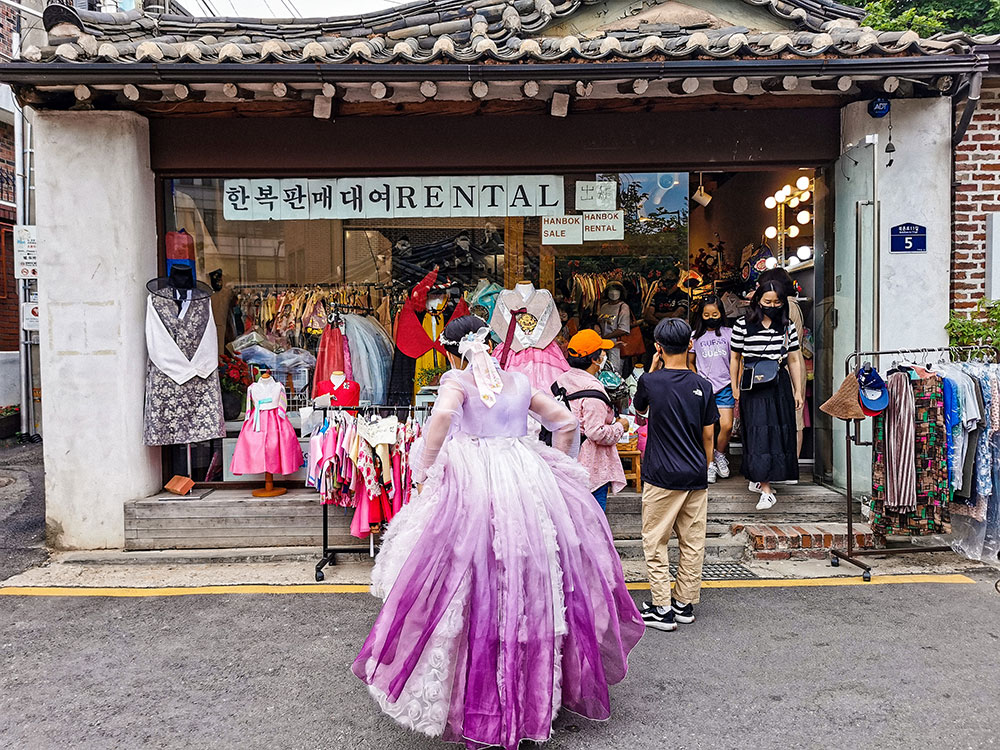
Hanbok Rental Store in Bukchon Hanok Village, Copyright © Cooltourismical.com
They say that no trip to Korea is complete without trying on a hanbok. But there is so much more about it. Instead, I would call it a particularly auspicious time travel opportunity.
The Korean traditional attire is kind of an unique wearable cultural heritage. Like any magical artefact, with the right setting, it can take you hundreds of years back. Or make you feel like you are taking part in a historical K-drama. Either way, it will be all about Joseon Dynasty. Indeed, the hanbok is much older than that, but the shape of the Hanboks you can rent around Bukchon Hanok Village are mostly inspired by clothes of those times.
The hanbok, in its silent dignity, is similar to an architectural masterpiece.
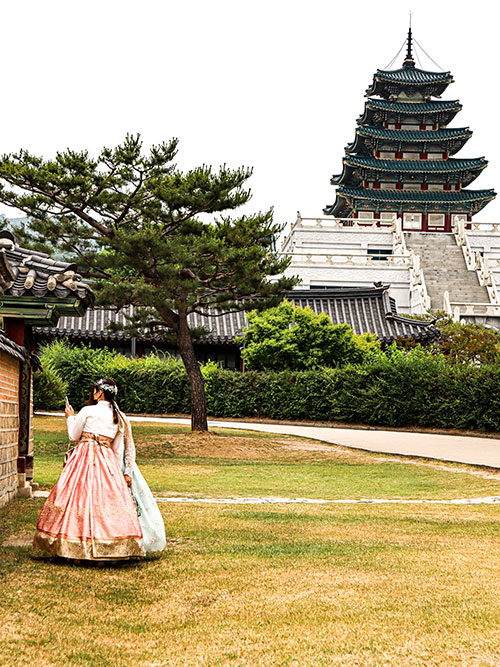
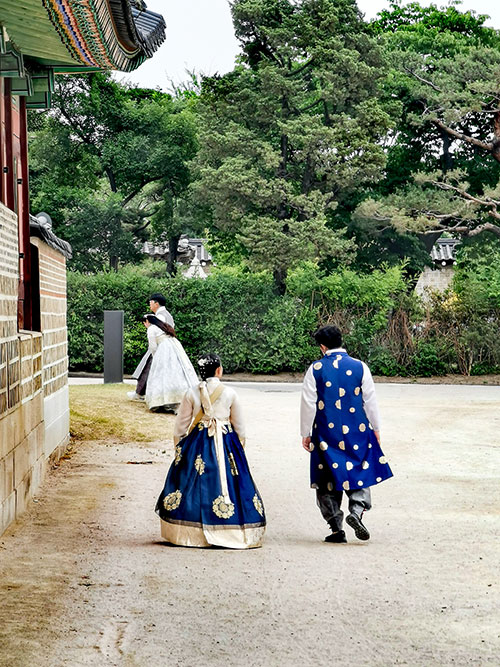
Hanbok Wearing, Copyright © Cooltourismical.com
The way it is stitched and the straight-lined fabric itself (hemp, silk or cotton, mostly silk imitation nowadays) give, by blending, a simple structural beauty that is hard to find in any other type of clothing. Its depth creates an irreplaceable sensation of rhythmic, free flowing effect, even at the smallest of our body’s movements while wearing it.
No need to be shy. A lot of people do rent hanboks. The streets of Bukchon and the nearby palaces are filled with tourists and locals alike, dressed up, posing against ancient walls. Living their own particular Joseon era stories.
Places where you can rent a hanbok in Bukchon Hanok Village, Seoul, South Korea:
📷 Get your retro-looking photo
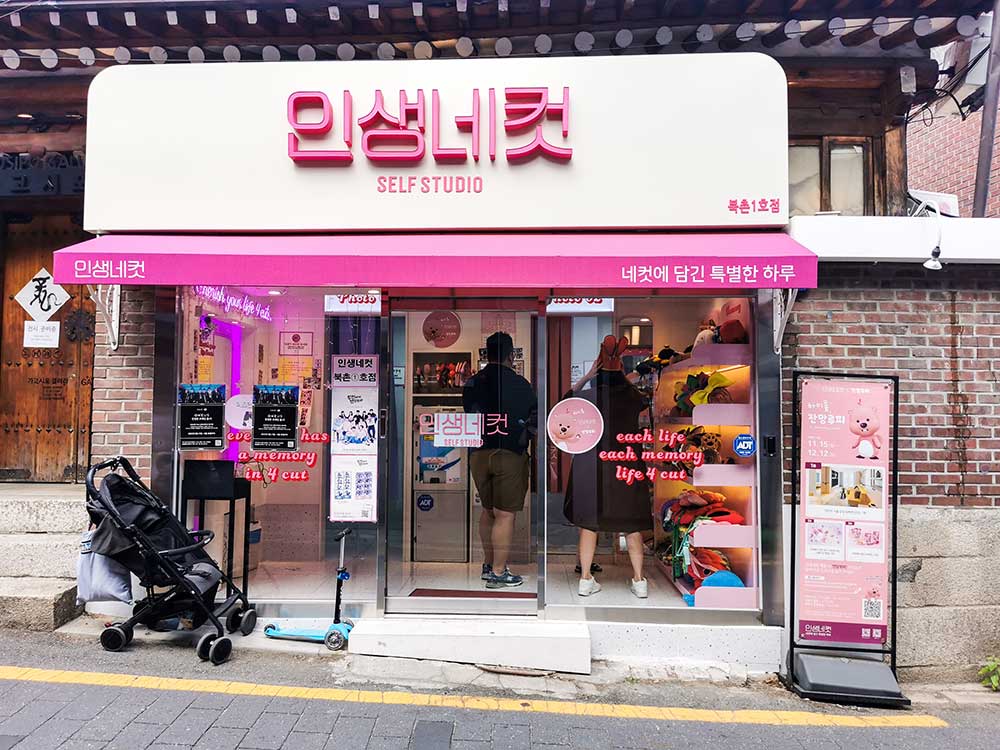
Selfies Studio in Bukchon Hanok Village, Copyright © Cooltourismical.com
Photo studios are very popular around Seoul as portrait photography has a long tradition in the Korean society.
This goes back as far as the beginning of 20th century when first film cameras entered South Korea. First studios started opening in 1907, while reaching a peak in the 90’s with almost 8000 studios just in Seoul. Now, they are less, but still very popular, especially among young people.
Either you want to make your hanbok wearing memorable, pose against an ancient setting or have your black and white portrait, you can choose one of the studios around Bukchon.
There are wonderful professional portrait studios that take you back in time by still using the same old film cameras. These can give you back a special memory, as well as an amazing experience. Or if you’re in for something more simple, but a lot of fun too, you can always pick one of the self photoshoot studios. They are equipped with a large variety of cute outfits and props.
Photo Studios in Bukchon Hanok Village:
- 📌 Sajin Mooee Studio, photos using old film camera: 종로구 계동 103-1, Seoul (Google / Kakao)
- 📌 Mulnamoo Photo Studio, black-and-white photos on discontinued Polaroid cameras: 84-3 Gyedong-gil, Jongno-gu (Google / Kakao)
- 📌 Vitoga Hanok Photo Studio, hanbok photoshoots: 8 Changdeokgung 5-gil, Gahoe-dong (Google)
- 📌 Selfie Studio in Bukchon: 16 Bukchon-ro 5ga-gil, Hwa-dong, Jongno-gu, Seoul, South Korea (Google)
🎈 Watch the rooftops from above – Bukchon Observatories
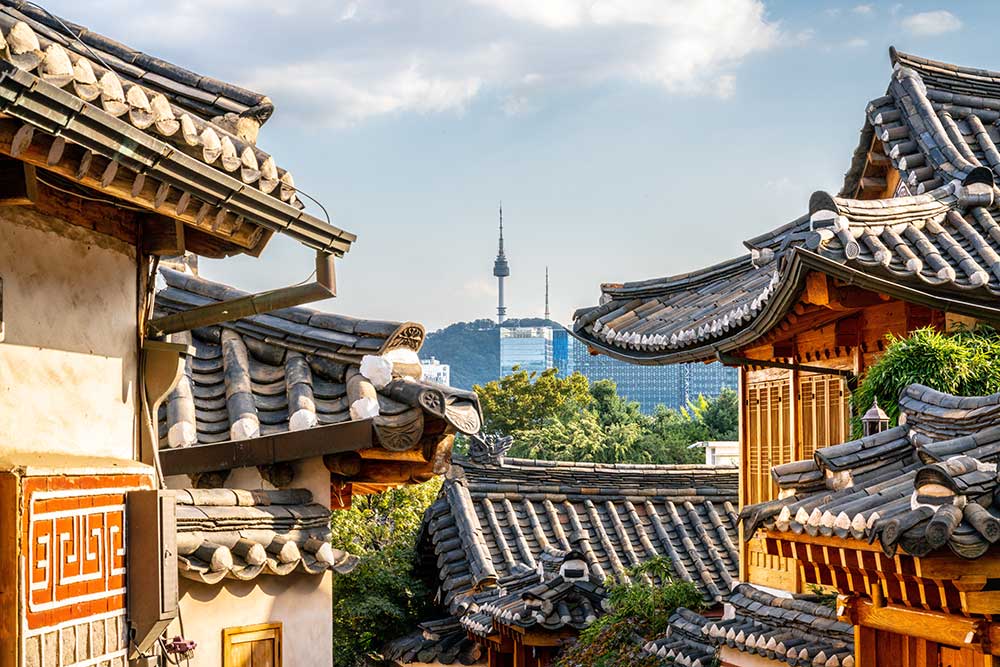
There are few things in this world that can be as charming as the vistas over Bukchon Village in Seoul.
A sea of Hanok tiled rooftops, with their unusual delicacy, are the still-standing proof of exquisite craftmanship and genius of the elders. So peaceful. So pleasing for the eyes.
The tiled roofs are easily curving upwards as if the wind has tried to blow them away. But they fought. And opposed. And time has helped them by carefully petrifying their dance for more generations to come. Lots and lots of rows of tiles are surrounding beautiful interior gardens and sturdy, wooden gates defining public and really tiny, private spaces.
Inside Bukchon Hanok Village, there are many hidden cafes, museums and observatories open to public, even private ones, where you can enjoy such spectacular panoramas.
Bukchon Hanok Village Rooftops Observatories
- 📌 Gahoe 2nd Floor Observatory: 33 Bukchon-ro 12-gil, Gahoe-dong, Jongno-gu | 서울특별시 종로구 가회동 북촌로12길 33 (Google)
- 📌 Bukchon Hanok Hall: 29-1 Bukchon-ro 12-gil, Jongno-gu, Seoul (Google)
- 📌 Bukchon Asian Art Museum Terrace: 76 Bukchon-ro 11-gil, Jongno-gu / 서울특별시 종로구 북촌로11길 76 (Google / Kakao)
- 📌 GreenMile Coffee Rooftop: 64 Bukchon-ro, Gahoe-dong, Jongno-gu / 서울특별시 종로구 가회동 북촌로 64 (Google / Kakao)
- 📌 Pottery Store & Café 우물길정원: 35-97 Samcheong-dong, Jongno-gu, Seoul ( Google / Kakao)
 Korean Art Encounters
Korean Art Encounters
Bukchon Hanok Village is like a museum itself. But beyond that, its walls hide so many interesting art spaces, some pretty quirky. Tens of galleries and museums out of which many can be visited free of charge.
🖌️ Bukchon’s Street Art: Korean Murals & Sculptures
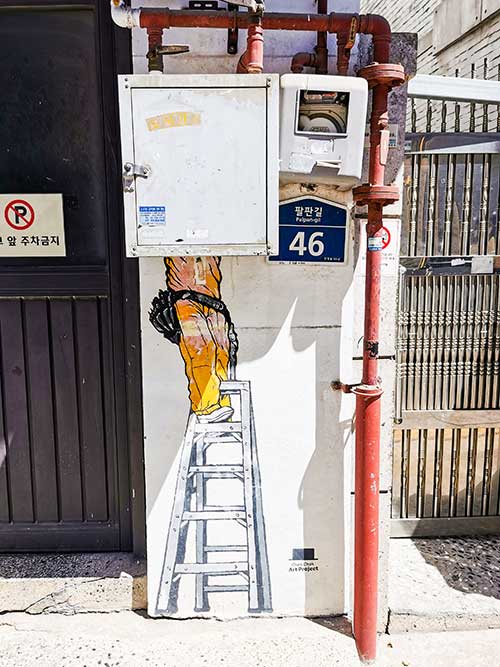
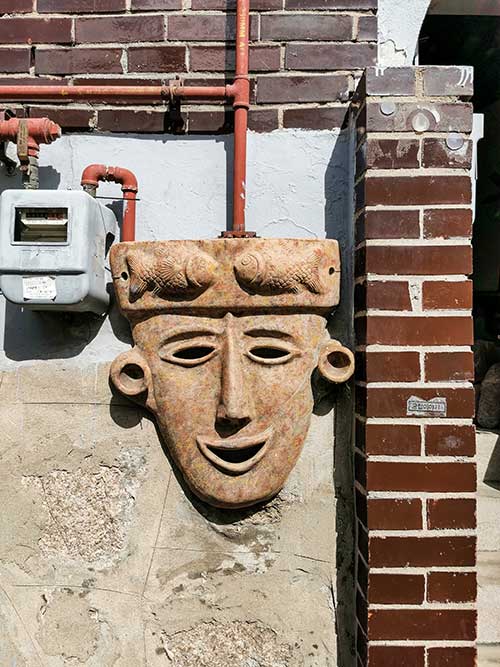
Street Art inside Bukchon Hanok Village, Copyright © Cooltourismical.com
Even if the traditional Korean village in Seoul keeps most of its exquisite, apparent-brick walls untouched, modern urban art has found its place and grown as in any other city. But somehow, in a peculiar way, every piece, either funny or cute, perfectly blends with the ancient setting, without disturbing its distinguished elegance.
Probably, one of the most beautiful graffities in Bukchon is “We are young” mural. A very heart-warming, black-and-white work of art located on Yolgok-ro 3-gil [율곡로3길]. Made in 2013 by a local artist, Wie Yeong-seon, the charming mural has become in time one of the most preferred locations for filming romantic K-drama scenes.
🏛️ Gallery Dam
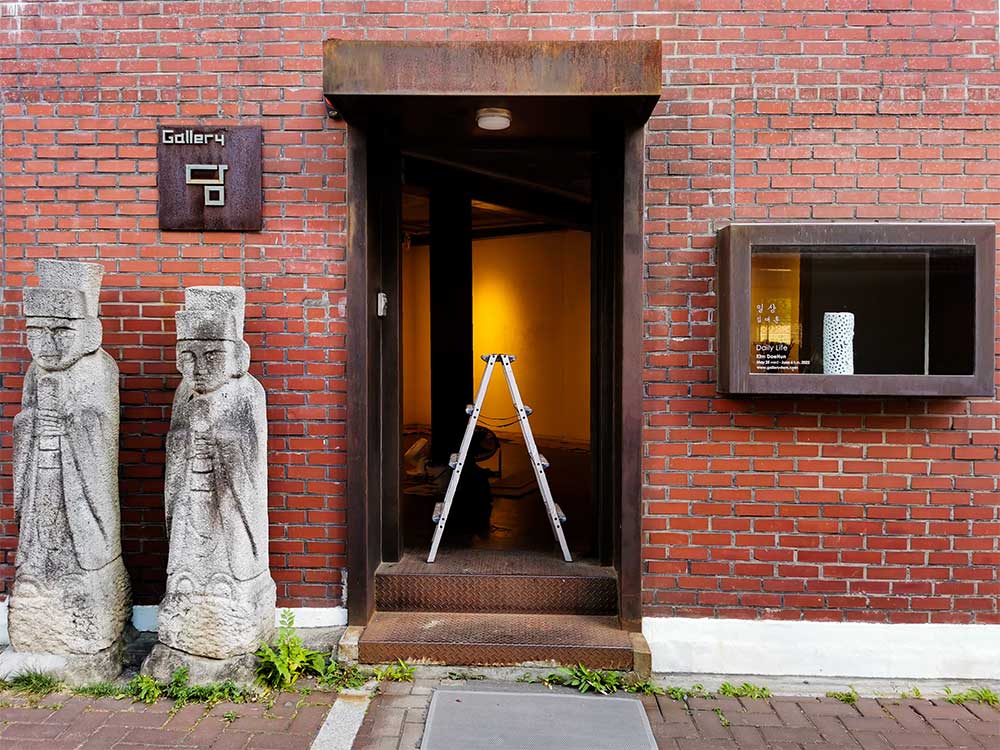
Gallery Dam Bukchon Hanok Village, Copyright © Cooltourismical.com
A reddish façade pierced by a small, teasing preview window and guarded by two mysterious statues conceals, in my opinion, one of the most interesting art venues in Bukchon area.
Gallery Dam, in its modest beauty, absorbs the rare and the uncanny, offering a kind of art that is deeply definitory for the uniqueness of each soul. Not as a response to a trend. But as a response to most tormenting artistic inspiration.
Each piece of art, either sculpture or painting or some kind of unexpected craft is a unique breath of someone’s daily life: curiosity, attraction, anxiety, research.
Dam has been introducing to the large public works of hundreds of emerging artists since 2006.
🏛️ Arario Museum in Space
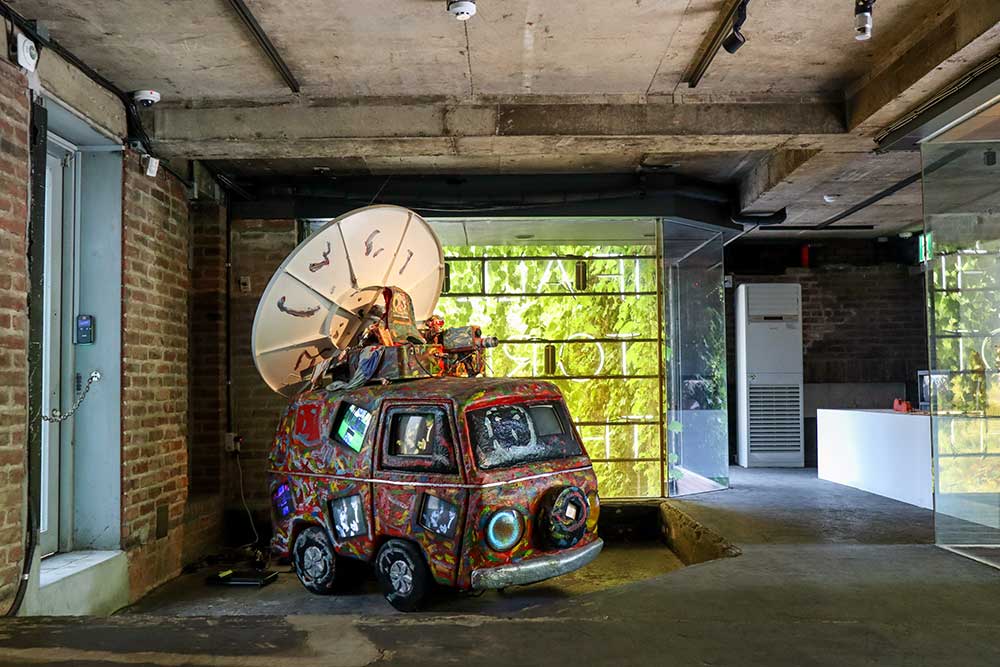
Arario Museum, Copyright © Cooltourismical.com
Hosted in an industrial warehouse, Arario museum is a multi-floor, maze -like space exhibiting some of the most unconventional pieces of contemporary art. The combination of metal, bricks, and semi-dark rooms, give an otherworldly, secretive ambiance in which every piece of sculpture, photography or painting finds its particular place.
The exhibits combine vintage elements with digital arts, highlighting the details in humans and nature, that we often overlook. Some of them tend to be slightly creepy. So, be ready for the unexpected.
🏛️ Gallery Hakgojae
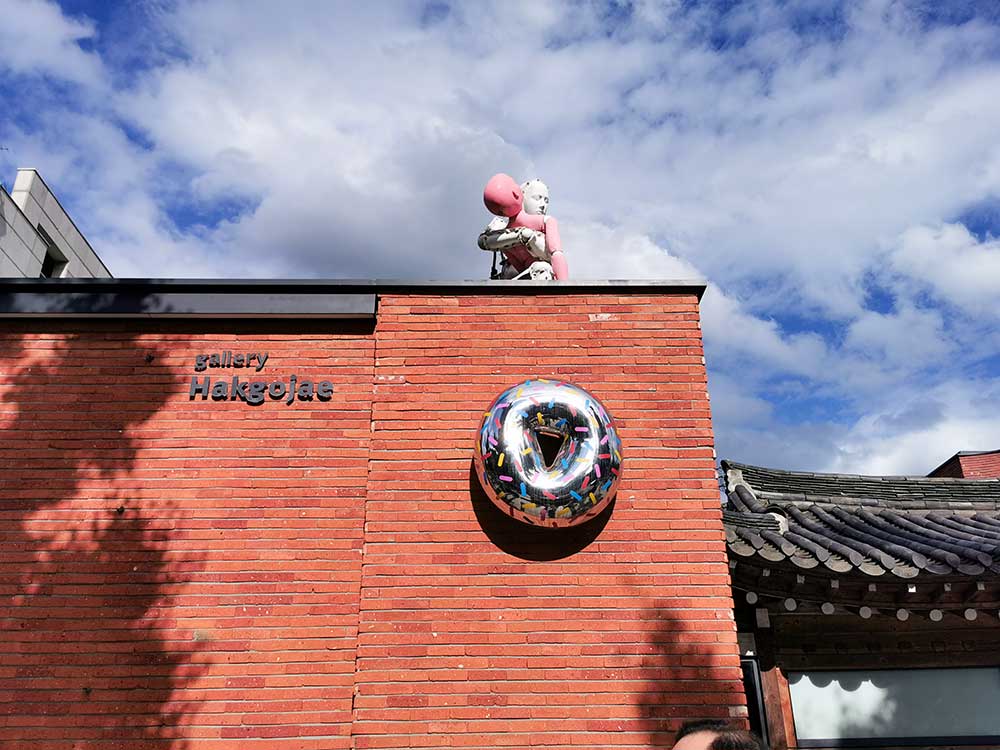
Gallery Hakgojae, Copyright © Cooltourismical.com
Hakgojae is pretty small, but often exhibits some of the best Korean findings. And it is surrounded by other very interesting galleries as well.
All exhibitions fit perfectly within the simple, but elegant interior, increasing the vibrance and of each work of art and inspiring visitors to pure harmony.
The pretty unusual donut on the main brick façade makes the antique hanok appearance even more cooler. And shines brightly, reminding of one of the cutest exhibitions ever: Kim Jae-Yong’s Pottery Exhibition, from whimsical, hugely-sized donuts to smaller ones covered in Swarovski crystals.
Other Galleries & Museums Worth Mentioning:
- 📌 National Museum of Modern and Contemporary Art Seoul (Google / Kakao)
- 📌 Gahoe Museum: 52 Bukchon-ro, Gahoe-dong, Jongno-gu / 서울특별시 종로구 가회동 북촌로 52 (Google / Kakao)
- 📌 Samchung Train Museum: 147 Bukchon-ro, Samcheong-dong, Jongno-gu, Seoul (Google / Kakao)
- 📌 Gagosipo Gallery: 16, Bukchon-ro 5-ga-gil, Jongno-gu, Seoul (Google / Kakao)
 Best eats in Bukchon Hanok Village
Best eats in Bukchon Hanok Village
No matter the hour you are planning to visit, there are plenty of restaurants in or near Bukchon Hanok Village and you will certainly find something special to eat. From old ladies cooking in a homey atmosphere a perfect English brunch to traditional eateries serving rice mussels or seafood pies and modern restaurants with international cuisine, it’s your call.
Still, I would say trying a traditional restaurant is a must. Koreans sustain a healthy eating style, most of their cuisine being based on grains and vegetables.
🍳 Coffee & Brunch (The Hanok)
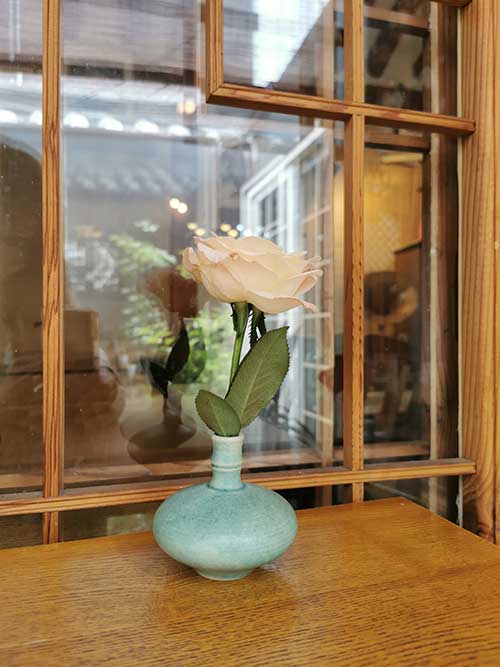
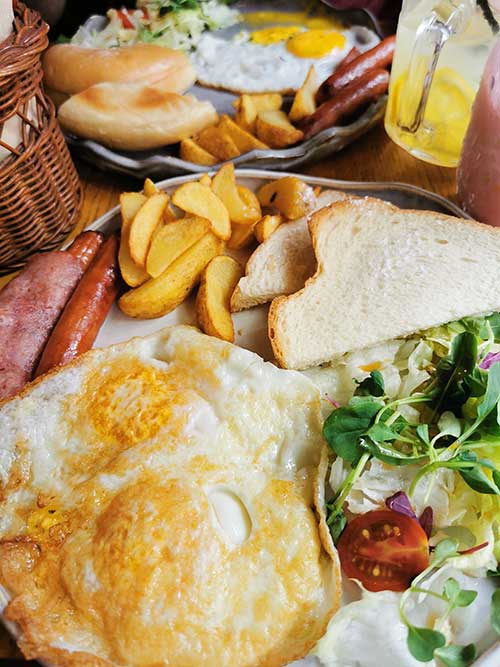
The Hanok Brunch, Copyright © Cooltourismical.com
With its solid, brick-and-stone walls, and small, fragile, wooden-frame windows, closed from all sides like a citadel, the Hanok, one of the pretties restaurants in Bukchon, is the perfect private space to enjoy a coffee. Or a meal. Made on the spot, by a very nice lady. Tiny rooms run along a narrow corridor, revolving altogether around the central piece of the Hanok, a charming courtyard.
This was the second Hanok where I could enter with my shoes on. In any case, I would have never regretted going barefoot either. This is a perfect jewel that’s worth preserving for generations to come.
🥗 Pink Rabbit Garden
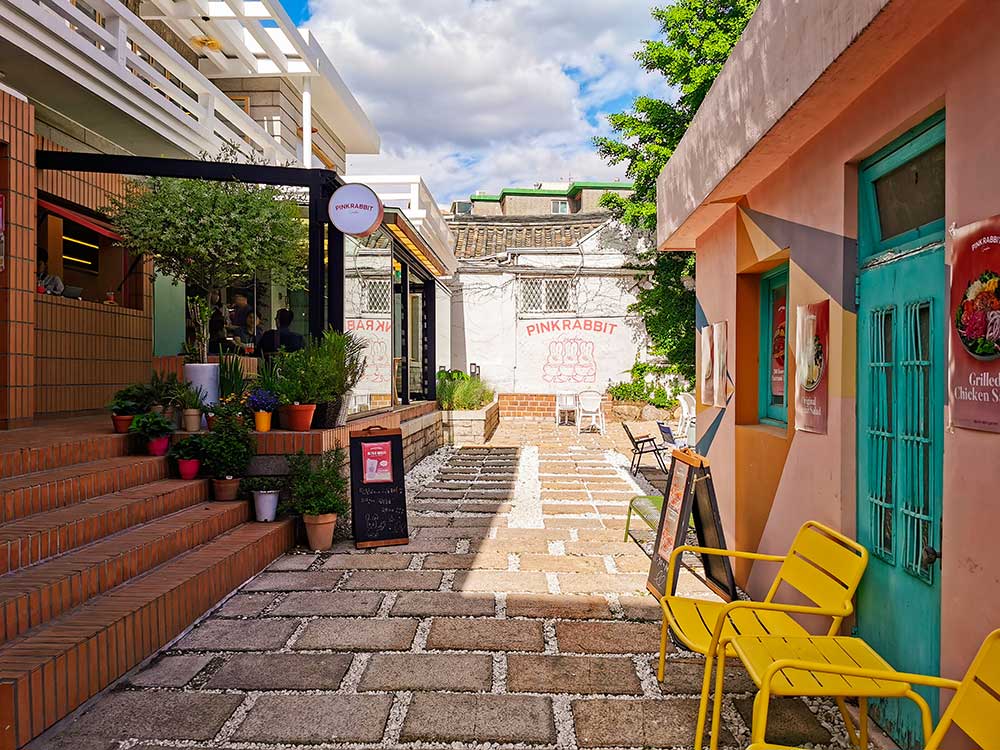
Bukchon Hanok Village, Pink Rabbit Entrance, Copyright © Cooltourismical.com
Well, as the name suggests, it’s mainly a Garden. But also the interior is not to be neglected. Large windows on the first floor and a 2nd floor, loved by many thanks to the hanok view.
The atmosphere is casual and fun, perfect spot to relax in a close-knit place like Bukchon. And the menu is slightly more diversified. They serves soups, fresh salads and pretzel sandwiches.
Prices range between 4000 -10000 won.
🍚 Cheongsujeong
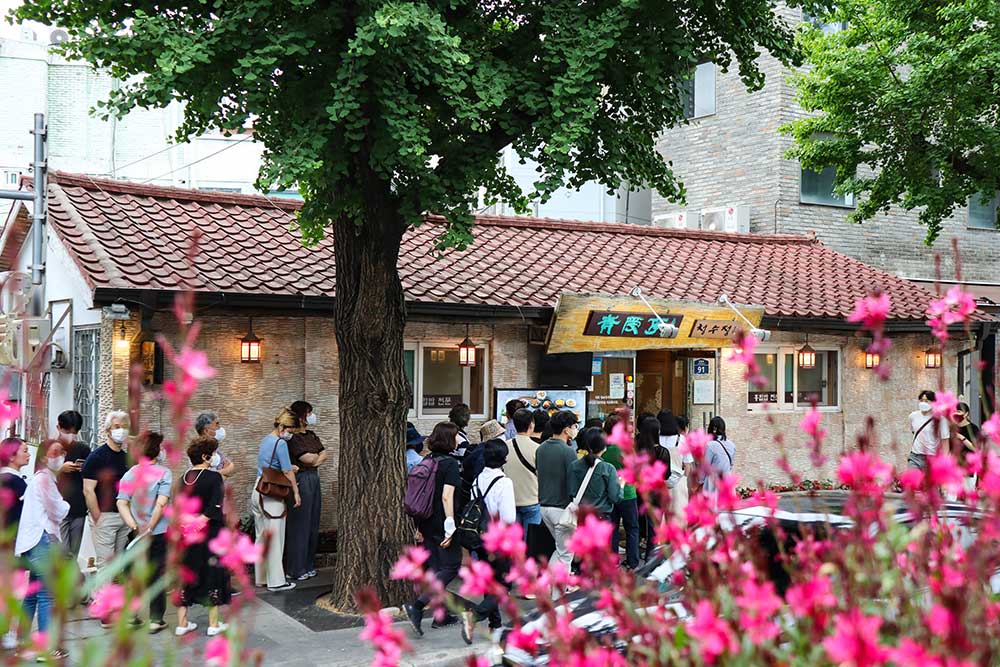
Cheongsujeong Traditional Korean Restaurant, Copyright © Cooltourismical.com
At lunch time, a whole bunch of people sit in line, along the vintage façade, waiting to eat honghapbap. Or mussels rice. A local, fried rice specialty seasoned with soya sauce and sesame oil, that comes along with around 10 delicious side dishes. For only 15 000.
It is one of the most crowded restaurants near the traditional Seoul village. And it takes about 30 to 40 minutes to be given a table.
Some love it, some hate, but analysing the cue, the way food is displayed on the plate and the lower price compared to the rest of the restaurants in the area, this might be a good choice for trying out some Korean traditional dishes in their particular setting.
🍜 Samcheongdong Sujebi
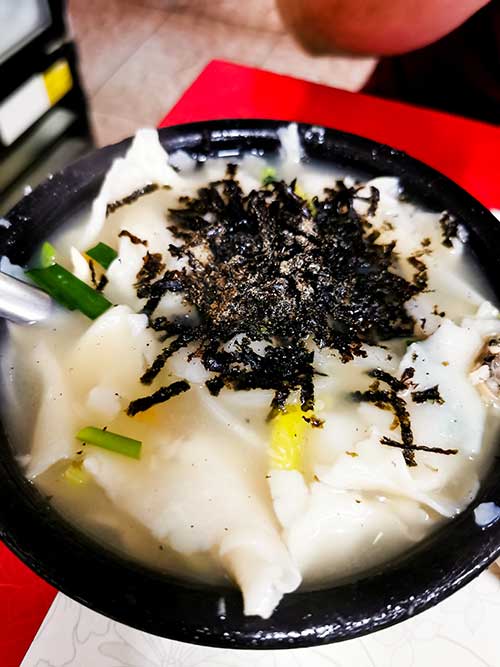
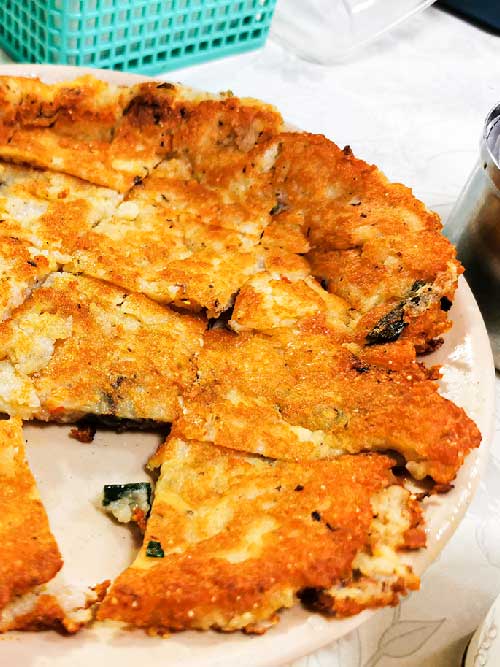
Sujebi Restaurant in Bukchon Hanok Village, Copyright © Cooltourismical.com
Located really close by to the previous one, the cue for this long-established Korean restaurant unfolds outside on two rows during lunch time. The space inside is also much bigger, but still pretty packed from around 12:00 to 16:00.
The atmosphere is similar to one of a canteen, where things happen really fast, without too much involvement. And obviously, food is served in unpretentious dishware.
It might not be anything WOW about it, but still a good opportunity to try out some traditional Korean pancakes, Sujebi (chewy dough flakes / Korean-style pasta, cooked in broth, along with vegetables) and Makgeolli (Korean rice wine).
We had potato pancake, onion pancake, as well as Sujebi and we paid around ₩35000. Kimchi comes for free!
🥯 London Bagel Museum
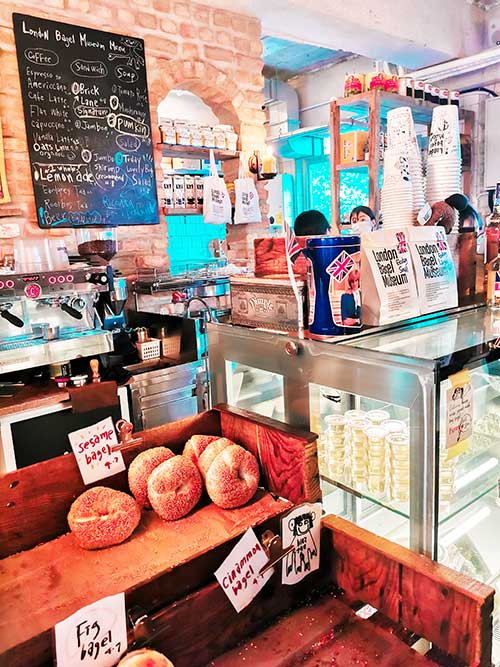
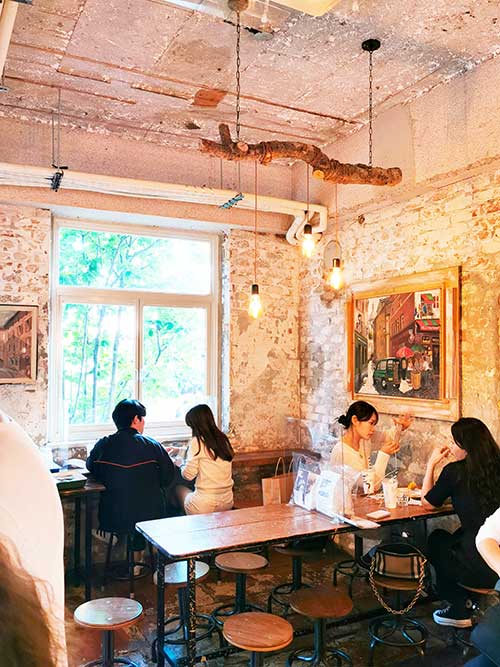
London Bagel Museum, Seoul, Copyright © Cooltourismical.com
Each time I passed by the London Bagel Museum, the cue was longer than my patience could handle. Until curiosity pushed me in and made me resist the crowds fiercely.
Across the street form the Paris Baguette, there is this other bakery. Which it is not just a bakery. But a celebration of UK aristocracy and… bagels. It is indeed a place where you want to take more pictures than eat bagels. Besides that, prices can be around 7000 won / bagel. But the taste is divine. As well as the British-inspired setting.
🍦 Café Aboong
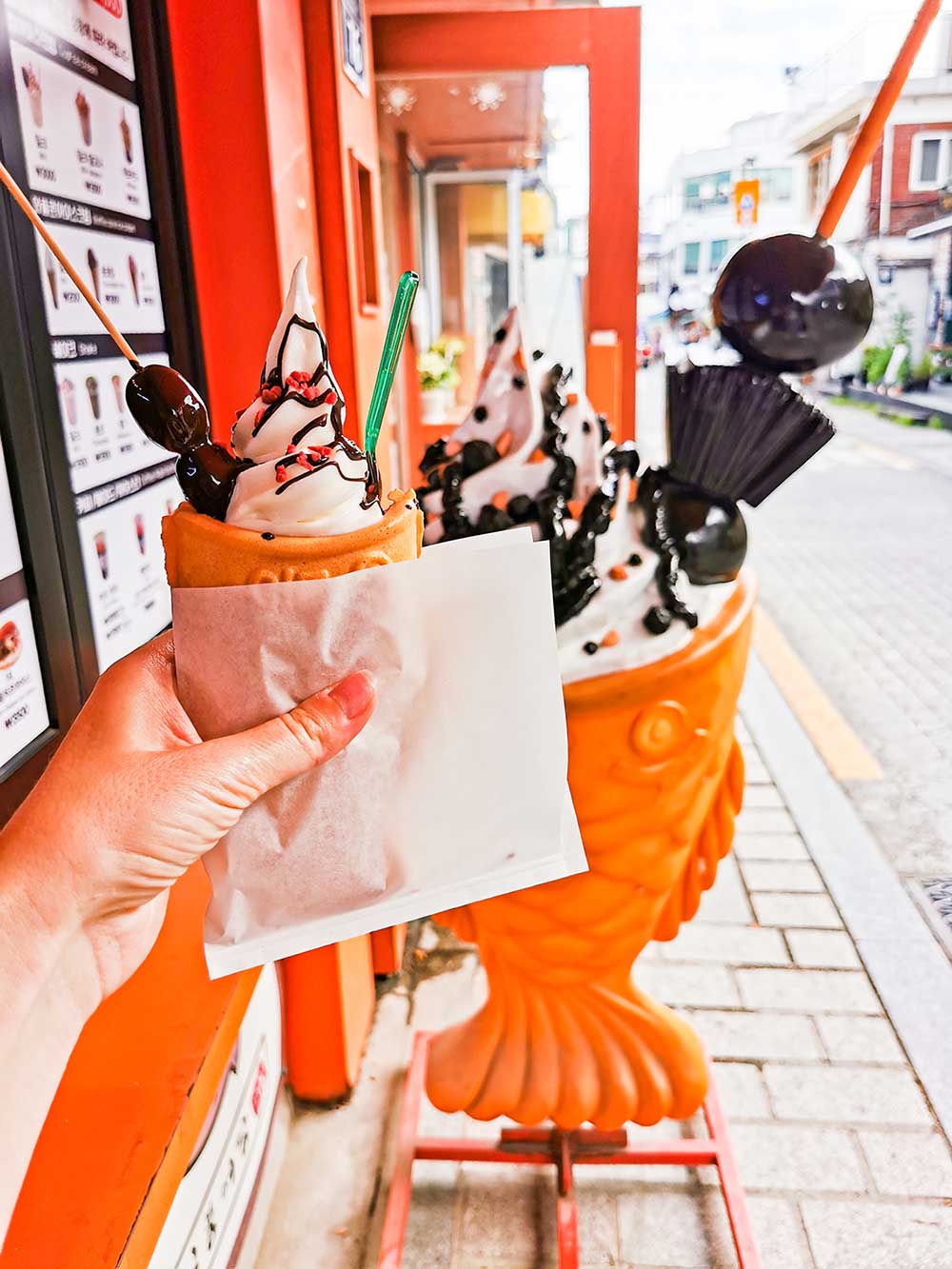
Bungeoppang Ice Cream, Copyright © Cooltourismical.com
A simple stall serving ice-cream. But what a funny one!
This is the perfect place to taste the infamous Bungeoppang Ice Cream, right on the streets of Bukcheon Hanok Village. The cone is a crispy waffle, fish-shaped bun, filled with red beans and premium ice-cream. Chocolate and crunch sit on top along with a fruit skewers dressed up in chocolate fondue.
Yummy!!
- 📌 Address: Seoul, Jongno-gu, Gye-dong, 129-7 (Google Maps Location)
 Lovely Hanoks to Spend the Night
Lovely Hanoks to Spend the Night
Having a sleepover inside an ancient Korean home is a captivating and life transforming experience, especially from an architectural point of view.
When I was in University in Bucharest, while studying foreign architecture, the classes had their focus on mostly modern types of Asian living spaces. And less on the traditional ones.
That is why, for me, spending a few days in Bukchon Hanok Village was an unexpected lesson on Korean traditional architecture. One that can only be lived, not taught.
🌸 Spending time in a hanok is all about IMMERSION
You can close your eyes and listen to the sharp whispers of the stones in the courtyard. They are slowly pushing each other away, trying to sink and spread in the hard ground, under your shoes.
Barefoot, you step up, a few centimeters only, just to find yourself on the the hardwood flooring of the maru, the main hall, the beating heart of the house. You slowly slide the framed doors of your room to let the light caress your eyesight through the Hanji. That modest, rustling paper gives the house the power to breath at the same time with you.
You sit in a corner, on the futon, resting. And you feel protected by this tiny room. Without even noticing, you get completely caught up in the life of the house itself. A pure connection with nature though a special manmade magical environment.
Ready to choose your stay?
🪵 Bukchonmaru Hanok Guesthouse
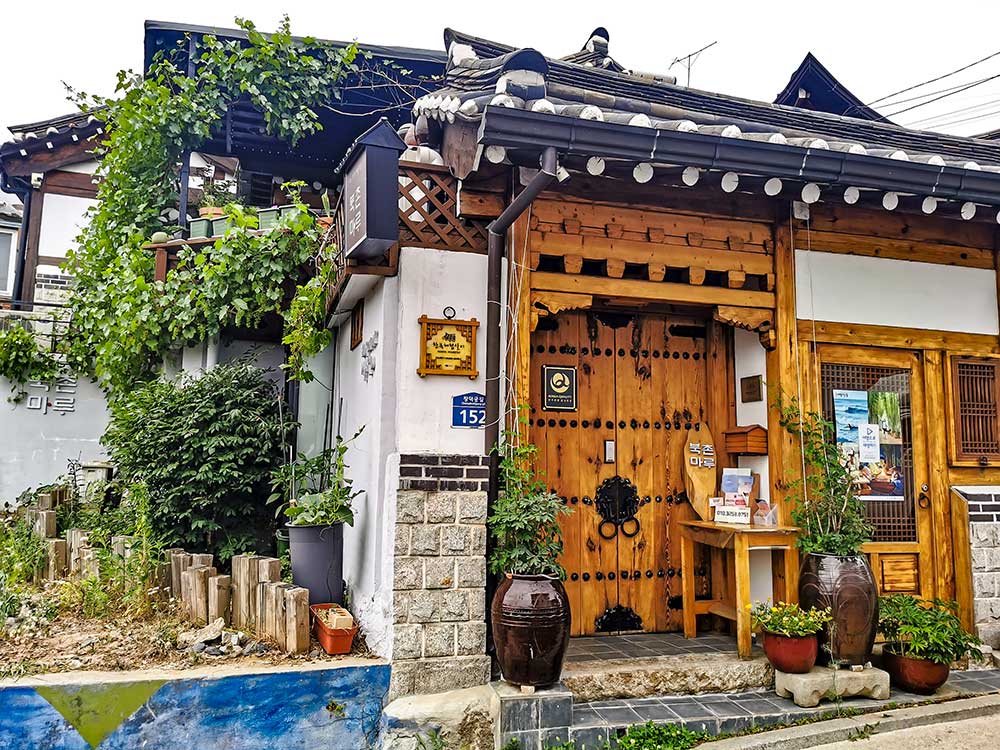
Bukchonmaru Hanok Guesthouse in Seoul, Copyright © Cooltourismical.com
This is one wonderful, absolutely traditional Korean house, where I spent 2 nights during the month of May. It is located on the northern, more tranquil part of the Bukchon neighbourhood, but still close to important touristic spots.
The Hanok has a welcoming area aligned to the street, while the main building is more to the back, one floor up on the hill, with a terrace overlooking the nearby buildings. The sleeping rooms are intimately withdrawn and embraced by other Hanoks.
Every detail of the house makes you feel you have landed to another era: from the tiny rooms dressed up in Hanji to the exquisite craftmanship of the sliding doors. And all it’s warmth inhere. The wood, the owners.
- 📌 Address: 152 Changdeokgung-gil, Jongno-gu, Seoul
🪵 Rakkojae Guesthouse Bukchon Hanok Village
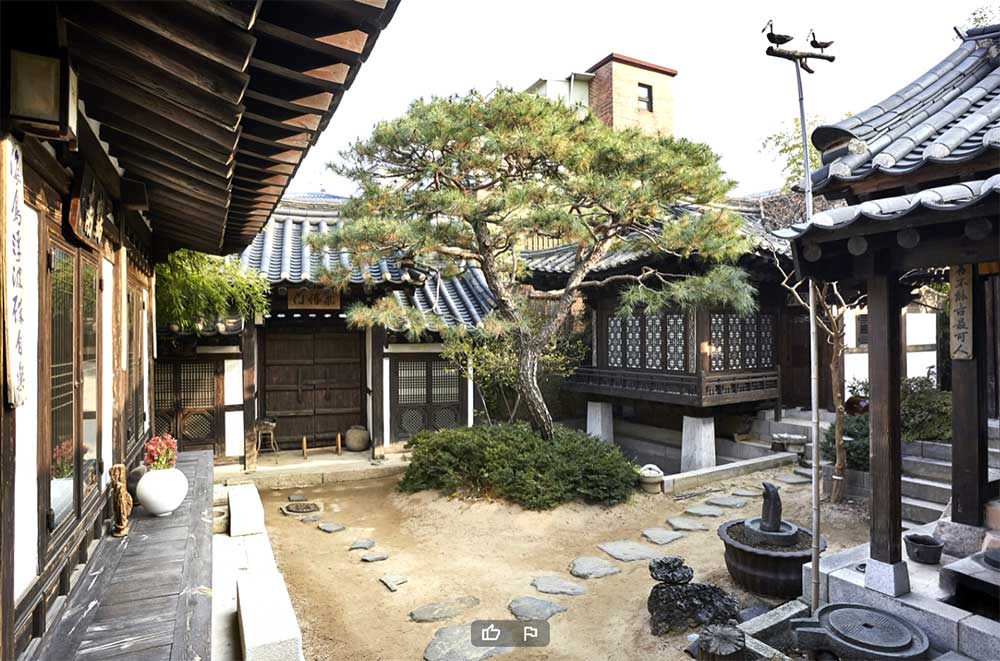
Image courtesy of Rakkojae Guesthouse
Rakkojae Guesthouse is a very, very lovely hanok stop for the night in the old Seoul village. ❤️
The rare aristocratic house of the Chosun Dynasty was transformed into one elegant and cozy hotel almost 20 years ago.
It has such a beautiful courtyard with a pavilion, a lotus pond and bamboo and pine trees scattered all around. An oasis of peace and tranquillity, perfect for reading a book at the heart of nature. It’s just like it was taken out of a historical K-drama when scholars, surrounded by nature, practice their calligraphy.
The quarters aligned around the patio are warm and finely decorated, with mattresses laid directly on the natural jade ondol floor. Still, the nicest addon of the Bukchon guesthouse is the yellow-mud sauna, heated with firewood.
It is quite a memorable accommodation around Bukchon.
- 📌 Address: 218 Gahoe-dong, Jongno-gu, Seoul / 서울특별시 종로구 가회동 218
🪵 Stay 256
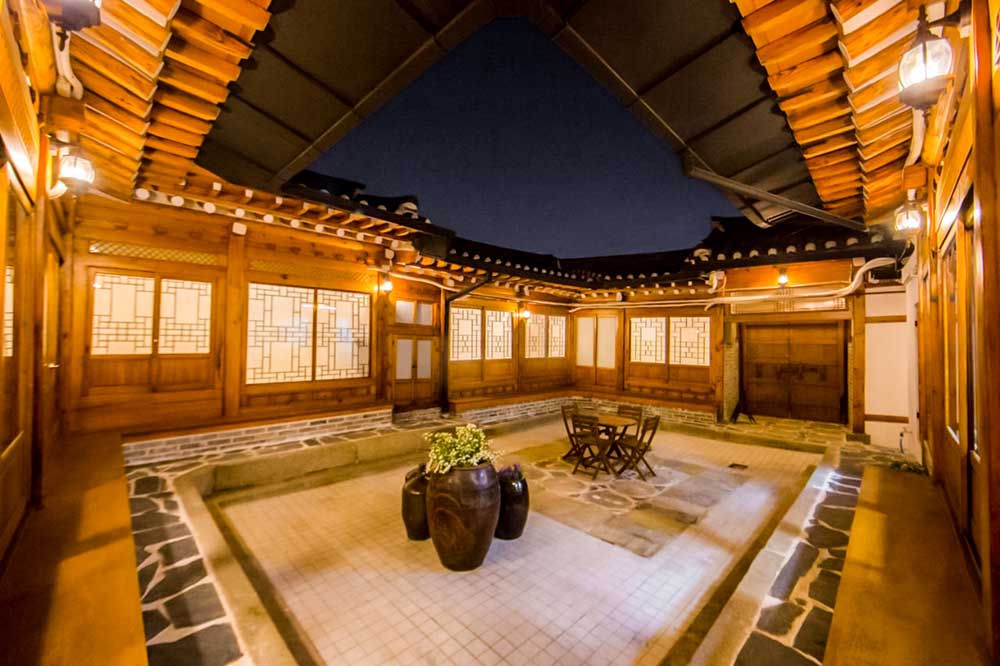
Image courtesy of STAY256 Hanok Guesthouse
Surprisingly tucked away on a small and quiet side alley, right in the heart of a tourist packed area of Bukchon, this cozy guesthouse seems like a secret confined only to a few chosen ones.
Each return to your tiny, antique0furnished room makes you feel like you are coming back HOME.
- 📌 Address: 104-10 Palpan-dong, Jongno-gu, Seoul / 서울특별시 종로구 팔판동 104-10
 Cozy Cafes & Tea Houses
Cozy Cafes & Tea Houses
Bukchon is overcrowded with nice gathering spaces where you can have a coffee or enjoy an authentic Korean tea house experience. Of course, all along with a delicious pastry, waffles or a famous Bingsu.
☕ Pottery Store & Café 우물길정원
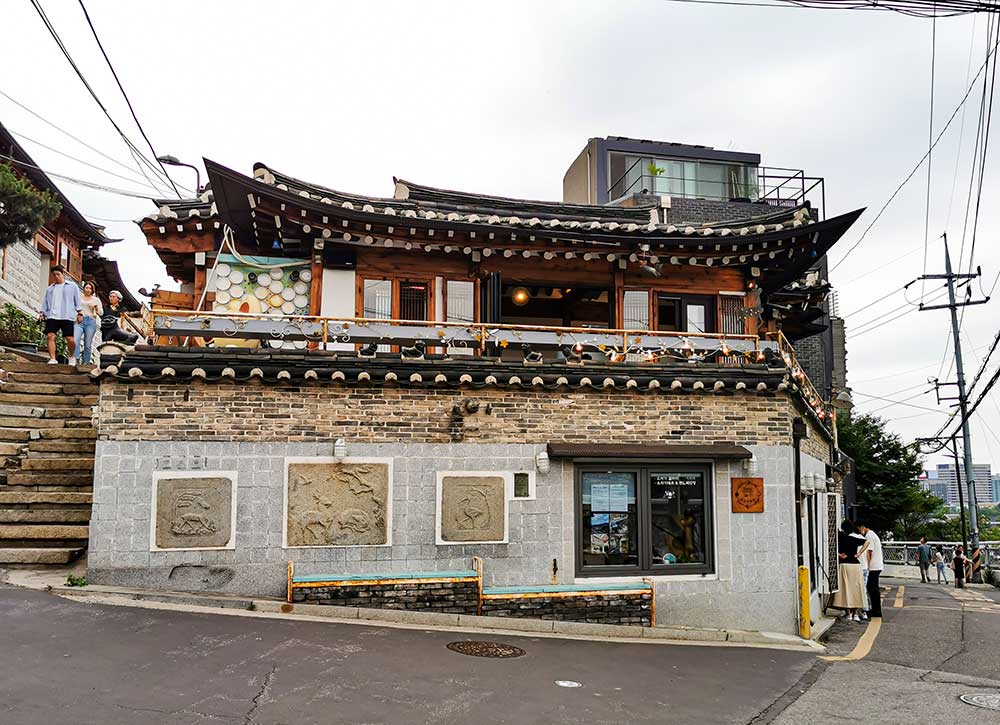
Pottery Store & Café in Bukchon Hanok Village, Copyright © Cooltourismical.com
I must admit that this extremely wonderful café is one of my favourite discoveries while walking on the maze-like streets of Bukchon Hanok Village. It is in fact more of an art space where people come to make pottery, draw, work and, above all, admire the beautiful view over the city.
It’s a corner building, with two floors, gathering with its unique beauty, people of all ages, from the adjacent streets.
Largely open windows on the first floor let the visitors admire all sorts of ceramic objects exhibited. The second floor, for which you have to pay a fee to access (which includes a drink) is quite special. It has a dreamy décor at the interior and a long, intimate terrace surrounding the construction on two sides. Perfect height toto enjoy an unbelievable panorama over Bukchon and nearby Folk Museum..
🫖 Tea Therapy
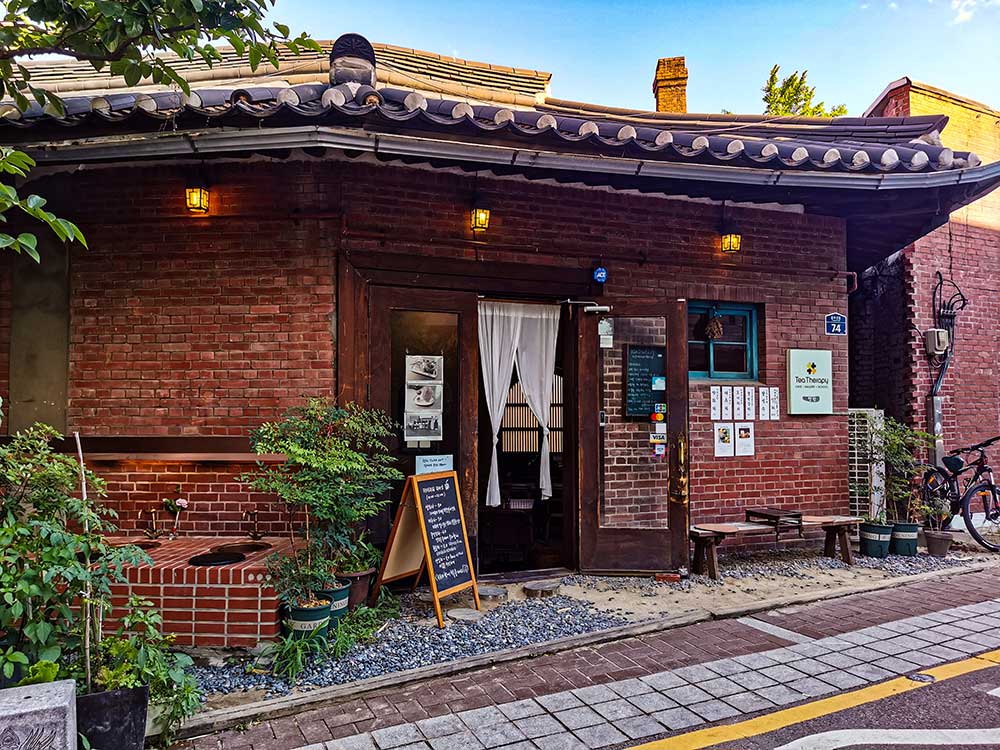
Tea Therapy & Foot Bath in Bukchon Hanok Village, Copyright © Cooltourismical.com
I had just passed Gallery Dam and its neighbouring building, a small tea house, when suddenly my peripheral vision caught a slightly awkward detail. This second building had a few cute water basins, sitting quietly in a row, just next to its main entrance.
The fact is that Tea Therapy tries to cure and relax your body, going beyond the services of a simple tea house. It’s a cozy place, where you can enjoy a healthy cup of tea based on a short analysis of the problems your body confronts with. And this comes along with a complimentary foot bath experience to improve your circulation and relax you.
They also serve lunch!
I admit bathing your feet in public is a bit awkward, but overall is an interesting experience.
🫖 Tea House Kkikdageo
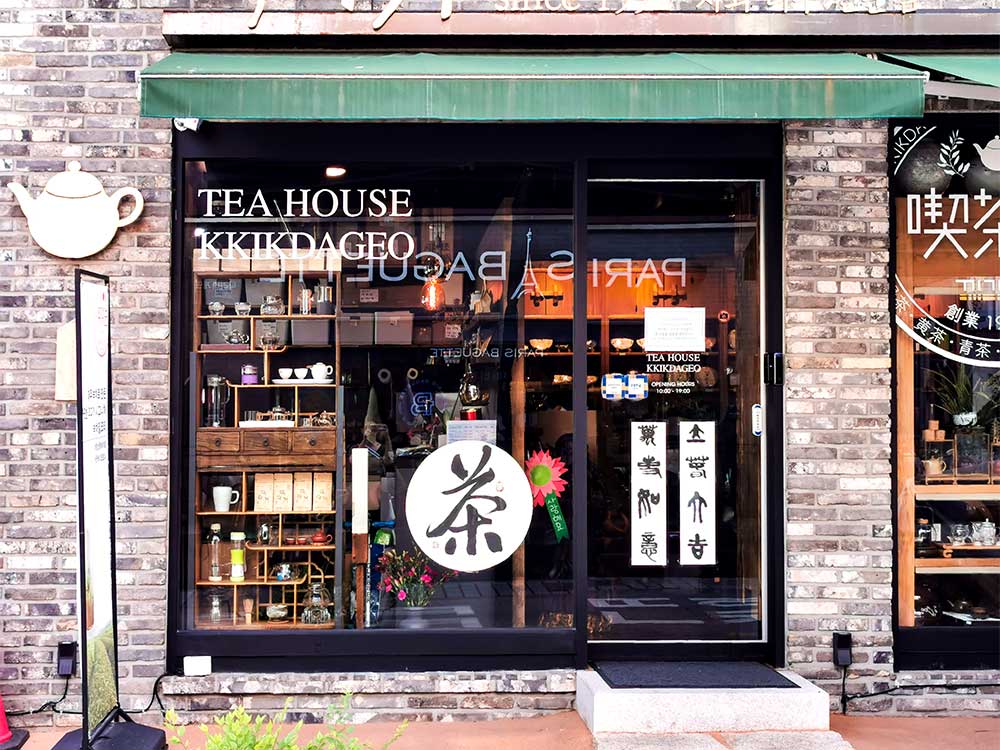
Kkidageo Traditional Tea House in Bukchon Hanok Village, Copyright © Cooltourismical.com
With a history dating more than 30 years back in time, this pretty traditional teahouse is serving a quite big range of fine teas. And from time to time, field trips to tea plantations, wonderful tea history classes or lectures, sharing in this warm way, with everyone, the magic of their extensive experience.
It is the right place to have a tea, eat an ice cream and unearth the most hidden secrets of tea culture and the special ceremony that flourished during the long-gone Tang Dynasty of China.
 Things to Know Before You Go
Things to Know Before You Go
There are many questions that come to our mind each time we think about visiting a place.
Same happens with Bukchon Hanok Village. Even if it is just a neighbourhood in Seoul, its many things to enjoy make the place pretty complex and labyrinthine. Hence, there are a few things to keep in mind while visiting, so you can make the most out of your experience around the traditional village.
💰 Entrance fee to visit Bukchon Hanok Village
There is no entrance fee to visit Bukchon Hanok Village, as it is a conglomerate of pretty streets, where people live, shop, eat, walk and take beautiful pictures. However, there might be extra costs for different museums, galleries or activities you will want to try.
🤫 Bukchon Hanok Village is a residential area. What does this mean?
In Bukchon, many of the still-standing hanoks are homes for Korean people. Hidden behind the many shops and galleries, people enjoy their daily life like in any other district of Seoul.
With this in mind, you should be respectful at all times, keep silence, not trespass private properties or make residents uncomfortable while taking pictures.
🕐 Bukchon Hanok Village visiting hours
Well, obviously there are no gates to stop you from moving around the streets of Bukchon at night. But being one of the most popular tourist attractions in Seoul, Bukchon Hanok Village does have common sense visiting hours.
Bukchon can be visited from 10 am to 5 pm from Monday to Saturday, while on Sundays, the village rests.
🚶♂️ Getting around Bukchon Hanok Village
The Google app can only be used only partially as a Bukchon Hanok Village guide, having some places marked on it. It is also good to read reviews for restaurants or touristic spots. But, sadly, Google Maps walking option is not available inside South Korea.
However, you can still use Kakao Maps. It is a bit more basic and maps are automatically translated into English inside the phone app, but it can prove itself, especially on the twisting streets of Bukchon Hanok Village.
🕐 How much time do you need in Bukchon Hanok Village?
Well, the time spent in Bukchon Hanok Village can rarely be a matter of hours. It could take days or weeks exploring the streets. I spent 3 days just inside Bukchon and I felt I did not have time even for 20% of what this place can offer to its visitors.
💮 The best time to visit Bukchon Hanok Village
While many of the museums around Bukchon Hanok Village can be visited early in the morning, Bukchon is open to visitors after 10 am. Best time of the day to start is 10 am. And, if possible try to get there, in spring or autumn to avoid heat, rain and peak season. I was there in May and it was lovely.
📖 Lovely Books About All Korean Things
A wonderful book on the revival of traditional Korean architecture, Hanok Korean House, and how it can adapt to the modern world.
An entertaining intro to most intriguing aspects of Korean culture, from the etiquette of bowing to the designs on Korean currency. Plus, valuable insights on the proper way to open a Soju bottle!
Simplified recipes of authentic Korean dishes to quickly get you started on cooking your favorite meals.
Hopefully, this helped you to prepare your own list of activities and things to see in Bukchon Hanok Village. Try to not load your daily schedule, but take enough time to enjoy every bit of this ancient place in Seoul.





